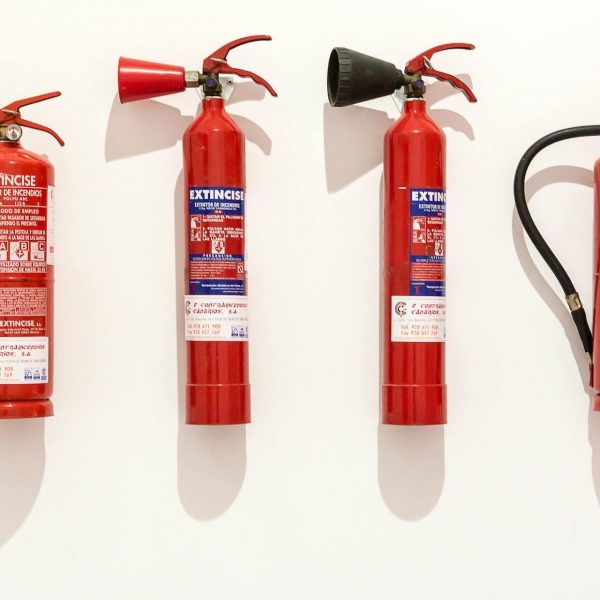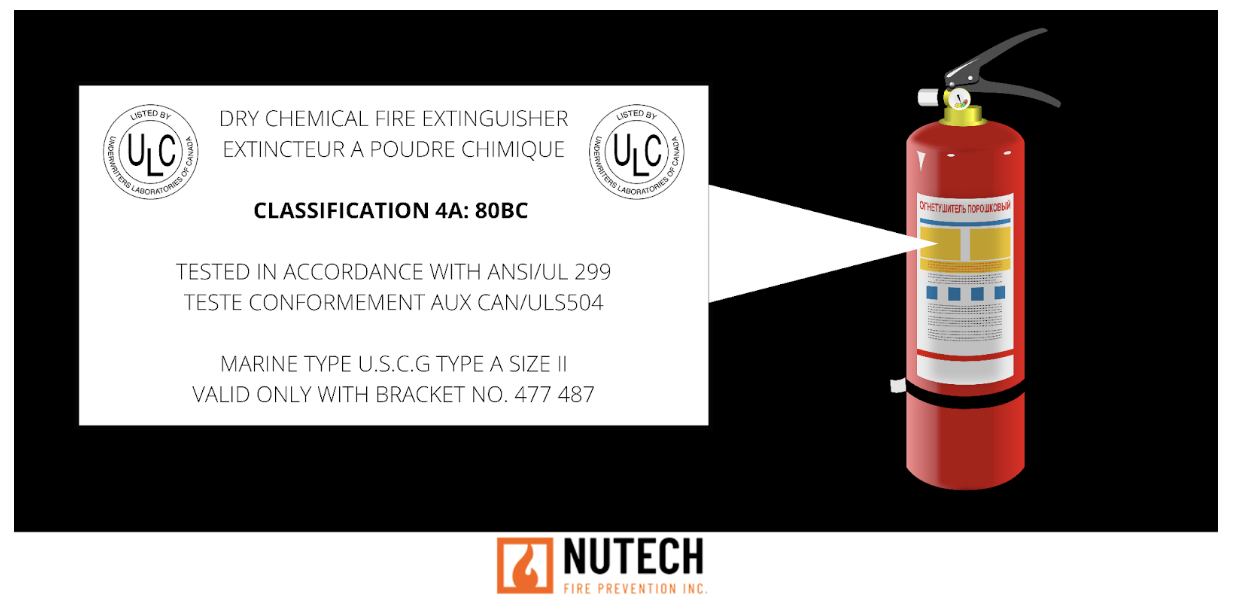
Have you ever wondered what the ABCs and 123s that you see on fire extinguishers mean? The proper term for these letters and numbering is fire extinguisher ratings.
But just what are they and what’s their significance when choosing a fire extinguisher for your business? Keep reading to find out and also to discover our top fire extinguisher tips.
Fire Extinguisher Ratings Explained
If you pick up a fire extinguisher and check its label, you’re going to see letters and numbers in a classification series. The format will look something like this 4A: 80BC

Here’s what you need to know about this rating.
The Underwriters Laboratory of Canada (ULC), a company renowned for its product safety testing, certification and inspection services, is responsible for issuing the ratings you see on fire extinguishers.
After subjecting respective fire extinguishers to a series of tests they accord each canister a rating that earmarks its designated use. And each rating will consist of a combination of letters and numbers.
What do the letters mean?
The letters are used as part of the fire classification system. The letter on the canister identifies which type of fire the fire extinguisher can effectively put out. For example:
Class A Fire Extinguishers smother fires where combustible products like paper, wood, or plastics are involved.
Class B Fire Extinguishers suffocate fires associated with flammable liquids such as oil and gas
Class C Fire Extinguishers extinguish electrical fires
Class D Fire Extinguishers quench fires comprising metals
Class K Fire Extinguishers douse commercial/residential kitchen fires involving grease and fats
What do the numbers mean?
Now that we know that the letters refer to the class of fire the fire extinguisher works best on, what about the numbers? What’s the number rating about?
This rating is best explained by using an example – 4A: 80BC
Let’s break down what this series of letters and numbers are telling us.
The letters are highlighting three classes of fire that can be suppressed – A, B, and C.
The number next to the A-rating tells us just how much water is in the canister. The 4 informs us that it contains about 16.5kg (4.5 gallons) of water.
The number (80) in front of the B and C represents the area in square feet that can be covered by the contents of the canister. In this case, this particular fire extinguisher can comfortably extinguish a fire over 80 sq ft.
So to put this all together, if we were to pick up a fire extinguisher labelled 4A: 80BC, we would immediately know from our understating of commercial fire extinguisher ratings the following:
This canister can handle fires involving paper, plastic, textiles, wood, gas, oil, and electrical fires. And that the fire extinguisher contains about 4.5 gallons of water and can effectively clear fire in a space of up to 80 square feet.
Are Ratings Really That Important?
Perhaps you’re asking if ratings are really that important. The short answer is yes, and here’s why.
If you get the rating wrong and select a fire extinguisher that’s not suitable for a specific fire you can worsen the situation.
How?
For example, if you mistakenly opt to douse an electrical fire with a water-based fire extinguisher, the odds of you being electrocuted are very high. This is simply because water is a good conductor of electrical currents.
Similarly, when using powder-based fire extinguishers, these should only be used in outdoor settings because their chemical reactions can make it difficult to breathe if discharged indoors.
As you can see, being aware of ratings is pivotal for effectively extinguishing fires. Knowing the commercial fire extinguisher ratings means you can identify which fire extinguisher will be most suitable for which type of fire.
Now, let’s turn our attention to some fire extinguisher tips.
Best Fire Extinguisher For Your Business
At this point you may wish to know which is the best fire extinguisher for your business or home?
As fire specialists in Ontario, we typically recommend that homeowners should settle for an ABC extinguisher because of its broadspectrum nature. It covers wood, textile, paper, plastic, gas, oil, and electrical fires.
Such extinguishers work by discharging a fine non-toxic powder that suppresses the fire and thus prevents re-ignition.
For restaurants, office buildings, malls, warehouses, manufacturing enterprises and garages we suggest going for Class D and K fire extinguishers.
Advice For Handling Fire Situations
According to the Canadian Fire Safety Association (CFSA), so long as a fire is small and within a relatively confined area, you can attempt to extinguish it.
However, once it grows bigger you should never attempt to extinguish it. Instead, your main priority and that of everyone in the building should be immediate evacuation.
Once everyone is out and has assembled at your chosen meeting place you may proceed to call your local fire department.
Fire Extinguisher Life Expectancy
Do fire extinguishers expire? You may have already checked on the UL label for an expiration date and not seen one.
Generally, fire extinguishers will last you a good 10 to 12 years before you need to replace them. However, they should be regularly serviced to ensure that they are in good working order.
How often should these inspections be? At least once a month the gauge on top of the canister should be assessed to ensure the needle is pointing to the green area.
In the event that you do use the extinguisher or it is damaged for whatever reason, it must be immediately replaced. Checking the state of your fire extinguishers should be part and parcel of your business fire safety routine.
Need Help Choosing Fire Extinguishers for your Business?
Here at Nutech Fire Prevention we pride ourselves on being Hamilton’s leading fire specialists. We help home and business owners chose the most appropriate fire extinguishers for their premises. Get advice about fire extinguisher types and sizes and even a few fire extinguisher tips as well!
That’s not all as we also design custom fire safety plans, conduct on-site routine testing, offer employee fire training, carry out gas detection inspections, and maintenance of fire protection systems such as sprinklers, fire extinguishers, fire alarms, emergency lighting, emergency backup generators, and exit lighting.
Request a free quote today.
Looking for more insight? Check out these previous posts: